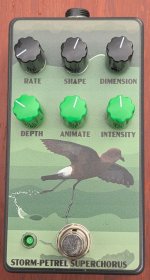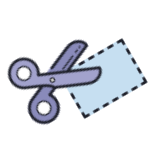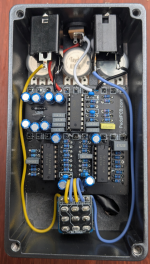rwl
Well-known member
- Build Rating
- 5.00 star(s)
This is my report on a build of the Sea Horse, based on the EQD Sea Machine. It's a chorus with a lot of cool options, similar to the Caesar. I feel like this pedal doesn't get much recognition - I'd recommend it!

Inspiration
I was thinking about distinct waterbirds that I hadn't based any pedals on, perhaps something that was 'super' to match the fancy superchorus name, and settled on the Storm-petrel. There's a huge number of storm-petrels; I can't recall which one I based this on, perhaps the Wilson's storm petrel - apparently one of the most common bird species on earth. That's super! Plus the storm petrel name is pretty dope.
There's two cool things about storm petrels: they will "dance" on the water's surface, flying very low over the ocean and tapping their legs on the water, it almost looks like running. That's what I tried to illustrate here. Additionally, the storm petrel has tube-like nostrils on the top of the beak. Albatross and regular petrels are also in the same family of birds. Petrels of all kinds tend to have very distinctive tubes at the top of the beak, which you can just make out on the pedal itself.
This is an older design, as you can see (when I was still doing full backgrounds with a gradient. I'm pretty happy with it, it's probably one of the more matural designs in that style, but I would probably design this pretty differently if I was making the pedal again.
The Build
A relatively straightforward build that I completed towards the end of 2024 before rehousing in the spring. I found this to be an easier, less crowded build than the Caesar (perhaps because that was in my very first batch of pedals), although it does have the 1/8W resistors (or you need to stand up 1/4W, which I find ugly). It fired right up and it's worked well since. Beyond making sure you have appropriate 1/8W resistors and some slightly idiosyncratic pot values, there's no particularly expensive parts or anything difficult to source.
The Pedal
It's a versatile chorus/delay thing. Of course you can do a bunch of wacky stuff with it, with pitch bending, different shaped curves, and slapback. There's demos on the EQD page. After half an hour of mucking around with some wild options though, you'll probably want to turn it down to something more consistently usable, and there it has a nice oscillation and resonance.
It's very similar to the Caesar/Julia, but there's two more pots; the Caesar just has a switch for the curve shape. I think that this can get even wilder than the Caesar. On the other hand, the sound is slightly more mechanical. I think the original "sea machine" name is apt. I'm ok with that, and I think I like the sound of the Sea Machine a little more than the Caesar, but they're pretty interchangeable. In the end, this kicked the Caesar off my board.
My only complaint, which I could fix if I wanted to, is that I don't like the oscillating light for bedroom playing. At least it's not on all the time, as I've seen with other pedals - I've found that distracting.
Build rating: 5/5
Pedal rating: 5/5

Inspiration
I was thinking about distinct waterbirds that I hadn't based any pedals on, perhaps something that was 'super' to match the fancy superchorus name, and settled on the Storm-petrel. There's a huge number of storm-petrels; I can't recall which one I based this on, perhaps the Wilson's storm petrel - apparently one of the most common bird species on earth. That's super! Plus the storm petrel name is pretty dope.
There's two cool things about storm petrels: they will "dance" on the water's surface, flying very low over the ocean and tapping their legs on the water, it almost looks like running. That's what I tried to illustrate here. Additionally, the storm petrel has tube-like nostrils on the top of the beak. Albatross and regular petrels are also in the same family of birds. Petrels of all kinds tend to have very distinctive tubes at the top of the beak, which you can just make out on the pedal itself.
This is an older design, as you can see (when I was still doing full backgrounds with a gradient. I'm pretty happy with it, it's probably one of the more matural designs in that style, but I would probably design this pretty differently if I was making the pedal again.
The Build
A relatively straightforward build that I completed towards the end of 2024 before rehousing in the spring. I found this to be an easier, less crowded build than the Caesar (perhaps because that was in my very first batch of pedals), although it does have the 1/8W resistors (or you need to stand up 1/4W, which I find ugly). It fired right up and it's worked well since. Beyond making sure you have appropriate 1/8W resistors and some slightly idiosyncratic pot values, there's no particularly expensive parts or anything difficult to source.
The Pedal
It's a versatile chorus/delay thing. Of course you can do a bunch of wacky stuff with it, with pitch bending, different shaped curves, and slapback. There's demos on the EQD page. After half an hour of mucking around with some wild options though, you'll probably want to turn it down to something more consistently usable, and there it has a nice oscillation and resonance.
It's very similar to the Caesar/Julia, but there's two more pots; the Caesar just has a switch for the curve shape. I think that this can get even wilder than the Caesar. On the other hand, the sound is slightly more mechanical. I think the original "sea machine" name is apt. I'm ok with that, and I think I like the sound of the Sea Machine a little more than the Caesar, but they're pretty interchangeable. In the end, this kicked the Caesar off my board.
My only complaint, which I could fix if I wanted to, is that I don't like the oscillating light for bedroom playing. At least it's not on all the time, as I've seen with other pedals - I've found that distracting.
Build rating: 5/5
Pedal rating: 5/5


